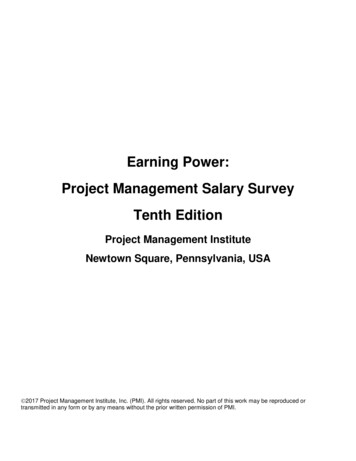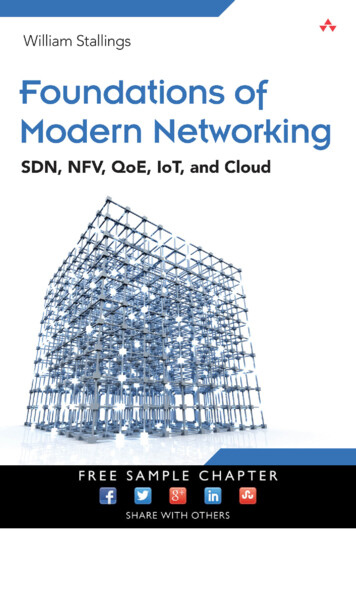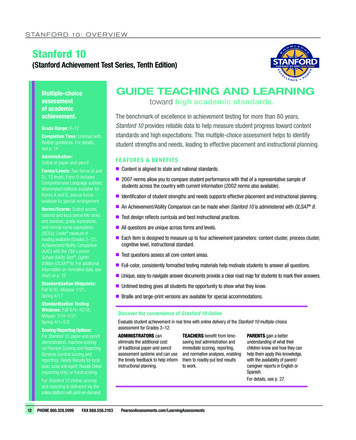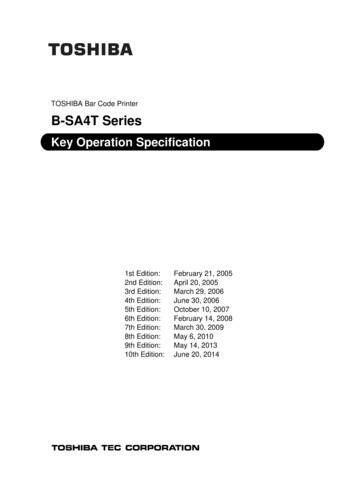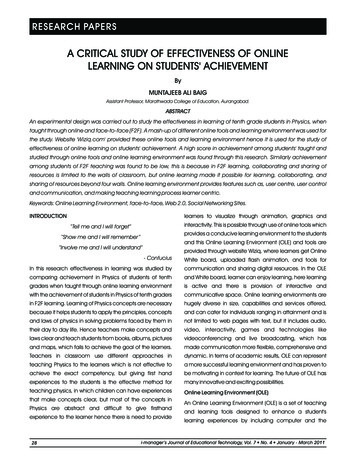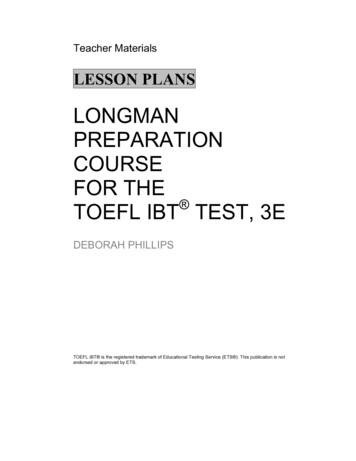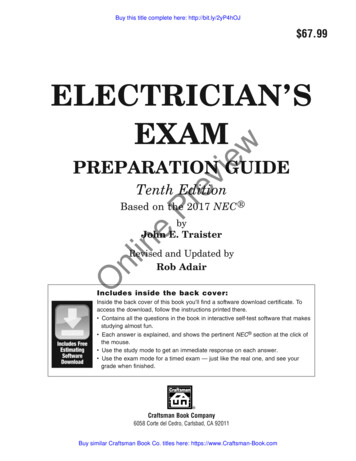
Transcription
Buy this title complete here: http://bit.ly/2yP4hOJ 67.99iewELECTRICIAN’SEXAMevPREPARATION GUIDEPrTenth EditionBased on the 2017 NEC inebyJohn E. TraisterOnlRevised and Updated byRob AdairIncludes inside the back cover:Inside the back cover of this book you’ll find a software download certificate. Toaccess the download, follow the instructions printed there. Contains all the questions in the book in interactive self-test software that makesstudying almost fun. Each answer is explained, and shows the pertinent NEC section at the click ofthe mouse. Use the study mode to get an immediate response on each answer. Use the exam mode for a timed exam — just like the real one, and see yourgrade when finished. Craftsman Book Company6058 Corte del Cedro, Carlsbad, CA 92011Buy similar Craftsman Book Co. titles here: https://www.Craftsman-Book.com
Buy this title complete here: http://bit.ly/2yP4hOJAcknowledgmentsWe are indebted to several individuals and organizations who helped in the preparation of this book.One group is the electrical examining boards throughout the United States. A list of these organizations appears in Appendix I of this book. The following were especially helpful in furnishing reference materials or else helping with the production.National Fire Protection Association (NFPA )C. Keeler Chapman, ArtworkJohn D. Lee, Sr., Question Verification & Code ConsultanteviewPortions of this publication are reprinted with permission from NFPA 70 -2017 National ElectricalCode , Copyright 2016 National Fire Protection Association, Quincy, MA 02169. This reprintedmaterial is not the complete and official position of the National Fire Protection Association on thereferenced subject, which is represented only by the standard in its entirety.inePrNational Electrical Code and NEC are registered trademarks of the National Fire ProtectionAssociation, Inc., Quincy, MA 02169.Looking for other construction reference manuals?OnlCraftsman has the books to fill your needs. Call toll-free 1-800-829-8123or write to Craftsman Book Company, 6058 Corte del Cedro, Carlsbad, CA 92011Visit our Web site: www.craftsman-book.comLibrary of Congress Cataloging-in-Publication DataNames: Traister, John E., author. Adair, Rob, 1946- editor.Title: Electrician’s exam preparation guide : based on the 2017 NEC(r) / byJohn E. Traister revised and updated by Rob Adair.Description: Tenth edition. Carlsbad, CA : Craftsman Book Company, [2019] Includes bibliographical references and index.Identifiers: LCCN 2019021329 ISBN 9781572183520 (pbk. : alk. paper)Subjects: LCSH: Electrical engineering--Examinations, questions, etc. Electrical engineering--Examinations--Study guides. Electricians--Licenses--United States. National Fire ProtectionAssociation. National Electrical Code (2019)Classification: LCC TK169 .T73 2019 DDC 621.319/24076--dc23 LC record available at https://lccn.loc.gov/2019021329 2019, 2014, 2011, 2008, 2005, 2002, 1999, 1996, 1993, 1991 Craftsman Book CompanyBuy similar Craftsman Book Co. titles here: https://www.Craftsman-Book.com
Buy this title complete here: http://bit.ly/2yP4hOJContentsIntroduction . . . . . . . . . . . . . . . . . . . . . . . . . . . . . . . . . . . . . . . . . . . . . . 5Electrical Systems — General Requirements . . . . . . . . . . . . . . 132Electrical Calculations . . . . . . . . . . . . . . . . . . . . . . . . . . . . . . . 373Branch Circuits and Feeders . . . . . . . . . . . . . . . . . . . . . . . . . . . 594Electric Services . . . . . . . . . . . . . . . . . . . . . . . . . . . . . . . . . . . . 895Distribution Equipment . . . . . . . . . . . . . . . . . . . . . . . . . . . . . 1176Overcurrent Protection . . . . . . . . . . . . . . . . . . . . . . . . . . . . . . 1377Utilization Equipment . . . . . . . . . . . . . . . . . . . . . . . . . . . . . . 1638Measuring and Testing . . . . . . . . . . . . . . . . . . . . . . . . . . . . . . 1839Electric Motors and Motor Controls . . . . . . . . . . . . . . . . . . . 20310Special Occupancies . . . . . . . . . . . . . . . . . . . . . . . . . . . . . . . . 22311Miscellaneous Applications . . . . . . . . . . . . . . . . . . . . . . . . . . 24512Transformers and Capacitors . . . . . . . . . . . . . . . . . . . . . . . . . 25713Electrical Drawings . . . . . . . . . . . . . . . . . . . . . . . . . . . . . . . . . 26914Final Examination . . . . . . . . . . . . . . . . . . . . . . . . . . . . . . . . . . 289OnlinePreview1Using the Interactive Study Center Download . . . . . . . . . . . . . . . . . . 340Appendix I State Contractor’s Examination Offices . . . . . . . . . . 342Appendix II Answers to Final Exam Questions . . . . . . . . . . . . . . . 345Index. . . . . . . . . . . . . . . . . . . . . . . . . . . . . . . . . . . . . . . . . . . . 346Buy similar Craftsman Book Co. titles here: https://www.Craftsman-Book.com
OnlinePreviewBuy this title complete here: http://bit.ly/2yP4hOJBuy similar Craftsman Book Co. titles here: https://www.Craftsman-Book.com
Buy this title complete here: http://bit.ly/2yP4hOJIntroduction —How to Use This BookwUnderstand also that the licensing authorityisn’t the enemy. They aren’t trying to keep youout of the electrical business. They only want toset some basic standards and be assured that yourinstallations will be done in a workmanlike manner and in accordance with the latest edition of theNational Electrical Code (NEC ). The publicshould be assured that all licensed electriciansare knowledgeable professionals. That’s good forsociety in general, and it’s good for all professional electricians and electrical contractors wholive and work in your area.PrevIf you are just starting your career as an apprentice electrician, this book is also for you. It beginsat the beginning. You will have no trouble understanding what is explained here. Read each pagecarefully and you will soon earn the recognitionthat licensed professionals are entitled to in ourpresent society. The financial rewards are anotherfactor which will make your efforts worthwhile.You can pass any electrician’s exam, but onlyif you study carefully each of the questions in thisbook. What you learn from studying is the foundation on which your professional career will bebuilt.ieIf you have been installing electrical systems forsome time as an apprentice, helper, or unlicensedelectrician, this book is for you. The informationbetween the covers of this book will cover everysubject that is likely to appear on most electrician’s exams — either state or local.OnlineIn most communities, any electrician workingwithout supervision must be licensed. For largerelectrical construction projects, many states nowrequire the certification of journeyman electriciansas well as specialty electricians, such as splicers ofhigh-voltage cable. This trend is certain to continue as legislatures recognize the need to protect thepublic from incompetents. The state of Virginia,for example, is now requiring all persons doingelectrical work to be licensed.Most licensing authorities prepare demandingexams that are a good test of the examinee’sknowledge. These exams help to guarantee thatelectrical systems installed in building construction will meet minimum standards for protectingthe lives and health of building occupants (andthe buildings themselves) for many years to come.This also helps to keep insurance rates to a minimum.Begin your study for any electrician’s examwith two points in mind: Take the exam seriously Every minute spent studying this bookincreases your chances of passing the examUnfortunately, there are too many applicantswho are not well prepared when they sit down totake the electrician’s exam. Taking an electrician’sexam without doing a good job of preparation is acomplete waste of time — both yours and that ofthe licensing authority. The results are predictable.Don’t make that mistake.The most common reason for failure is that theapplicant didn’t study properly because he didn’tknow how, or studied the wrong material. Thisbook should put an end to that excuse. You havein your hands the most complete, easiest-to-use,most practical reference available for preparingto take the tests that are actually given today.Read this book carefully, examine every question,understand all the answers. Do this, and there’s noway you will be unprepared on examination day.You are almost certain to score high.All the common questions and answers are here,but just knowing the answer is not always enough.Sometimes it is just as important to understandwhy a particular answer is correct. That’s whymany answers include a quotation or reference5Buy similar Craftsman Book Co. titles here: https://www.Craftsman-Book.com
Buy this title complete here: http://bit.ly/2yP4hOJElectrician’s Exam Preparation GuideNEC TerminologyThere are two basic types of rules in the NEC:mandatory rules and advisory rules. Here is howto recognize the two types of rules and how theyrelate to all types of electrical systems.Mandatory rules: All mandatory rules have theeviewterms shall or shall not in them. The terms meanmust. If a rule is mandatory, you must comply with it.Permissive rules: All advisory rules have theterms shall be permitted or shall not be required inthem. The terms in this case mean recommended butnot necessarily required. If a rule is advisory, compliance is discretionary. If you want to comply withit, do so. But you don’t have to if you don’t want to.PrOnlineThe National Electrical Code (NEC) has become the Bibleof the electrical industryBe alert to local amendments to the NEC. Localordinances may amend the language of the NEC,changing it from should to shall. This means thatyou must do in that county or city what may onlybe recommended in some other area. The officethat issues building permits will either sell you acopy of the code that’s enforced in that county ortell you where the code is sold.Learning the Layout of the NECThe National Electrical Code is used in practically every area of the United States for inspectingelectrical systems in building construction. Mostof the questions appearing on electrician’s examswill come directly from Articles and Sections ofthe latest NEC. Therefore a brief review of theindividual NEC sections that apply to electricalsystems is in order. Sample questions concerningall sections of the NEC may be found in the chapters to follow.Begin your study of the NEC with Articles 100and 110. These two articles have the basic information that will make the rest of the NEC easierto understand. Article 100 defines terms you willneed to understand when you apply the code.Previous editions of the NEC had some definitionslocated in the body of the code where the topicwas covered, but starting with the 2014 NEC, mostof these were brought together into Article 100 Definitions. Article 110 gives the general requirements for electrical installations. Read these twoarticles over several times until you are thoroughlyfamiliar with all the information they contain. It’stime well spent.This book, however, is not a substitute for theNEC. You need a copy of the most recent editionand it should be kept handy at all times. The moreyou know about the code, the more you are likelyto refer to it.Once you’re familiar with Articles 100 and 110,you can move on to the rest of the code. There areseveral key sections you will use often in servicing electrical systems. Let’s discuss each of theseimportant sections.section from the National Electrical Code.Sometimes you will find notes or clarificationsunder the answer when there is an important pointyou might miss.6Buy similar Craftsman Book Co. titles here: https://www.Craftsman-Book.com
Buy this title complete here: http://bit.ly/2yP4hOJIntroduction — How to Use This BookArticles 312 through 399 include rules for raceways, boxes, cabinets, low-voltage distribution,concealed knob-&-tube wiring, open wiring, andoutdoor overhead conductors. Outlet boxes varyin size and shape, depending on their use, the sizeof the raceway, the number of conductors entering the box, the type of building construction, andthe atmospheric condition of the areas. Chapter 3should answer most questions on the selection anduse of these items.evChapter 2 is also a “how-to” chapter. It explainshow to provide proper spacing for conductorsupports and how to size the proper groundingconductor or electrode. If you run into a problemrelated to the design or installation of a conventional electrical system, you can probably find asolution for it in this chapter.wChapter 2 of the NEC discusses wiring designand protection, the information electrical technicians need most often. It covers the use and identification of grounded conductors, branch circuits,feeders, calculations, services, overcurrent protection, grounding, bonding and surge protection. Thisis essential information for any type of electricalsystem, regardless of the type.Article 310 in Chapter 3 gives a completedescription of all types of electrical conductors.Electrical conductors come in a wide range ofsizes and forms. Be sure to check the workingdrawings and specifications to see what sizes andtypes of conductors are required for a specificjob. If conductor type and size are not specified,choose the most appropriate type and size meetingstandard NEC requirements.ieWiring and ProtectionWiring Methods and MaterialsOnlinePrChapter 3 has the rules on wiring methods andmaterials. The materials and procedures to use ona particular system depend on the type of buildingconstruction, the type of occupancy, the locationof the wiring in the building, the type of atmosphere in the building or in the area surroundingthe building, mechanical factors and the relativecosts of different wiring methods.The provisions of this chapter apply to all wiring installations except remote control switching(Article 725), low-energy power circuits (Article725), signal systems (Article 725), communication systems and conductors (Article 800) whenthese items form an integral part of equipmentsuch as motors and motor controllers.There are three basic wiring methods used inmost modern electrical systems. Nearly all wiringmethods are a variation of one of these three basicmethods: Sheathed cables of two or more conductors,such as NM cable and AC armored cable(Articles 320 through 340) Raceway wiring systems, such as rigid andEMT conduit (Articles 342 through 366) Busways (Article 368)The NEC does not describe in detail all typesand sizes of outlet boxes. But manufacturers ofoutlet boxes have excellent catalogs showing allof their products. Collect these catalogs. They’reessential to your work.Equipment for General UseChapter 4 of the NEC begins with the use andinstallation of flexible cords and cables, includingthe trade name, type, letter, wire size, number ofconductors, conductor insulation, outer coveringand use of each. The chapter also includes fixturewires, again giving the trade name, type, letter andother important details.Article 404 covers the switches you will use tocontrol electrical circuits.Article 406 covers receptacles and convenienceoutlets used to connect portable equipment to electric circuits. Get the manufacturers’ catalogs onthese items. They will provide you with detaileddescriptions of each of the wiring devices.Article 408 covers switchboards, switchgearand panelboards, including their location, installation methods, clearances, grounding and overcurrent protection.Article 409 covers industrial control panels.7Buy similar Craftsman Book Co. titles here: https://www.Craftsman-Book.com
Buy this title complete here: http://bit.ly/2yP4hOJElectrician’s Exam Preparation Guide Class III (Article 503): Areas that arehazardous because of the presence ofeasily ignitable fibers or flyings in theair, although not in large enough quantityto product ignitable mixtures. Class IIIlocations include cotton mills, rayon millsand clothing manufacturing plants.PrArticle 430 covers electric motors, includingmounting the motor and making electrical connections to it.Articles 440 through 470 cover air conditioningand heating equipment, generators, transformers,and capacitors. Class II (Article 502): Areas wherecombustible dust is present, such as grainhandling and storage plants, dust andstock collector areas and sugar-pulverizingplants. These are areas where, under normaloperating conditions, there may be enoughcombustible dust in the air to produceexplosive or ignitable mixtures.wArticle 422 covers appliances; 424 fixed electrical space heating equipment; 425 fixed resistanceheating equipment; 426 fixed outdoor deicingequipment and 427 fixed heating equipment forpipelines and vessels. Class I (Article 501): Areas containingflammable gases or vapors in the air. ClassI areas include paint spray booths, dyeingplants where hazardous liquids are used,and gas generator rooms.ieLow-voltage lighting is in Article 411.explosive atmosphere when arcing occurs withinthe electrical system.There are three classes of special occup ancylocations:evArticle 410 on lighting fixtures is especiallyimportant. It gives installation procedures for fixtures in specific locations. For example, it coversfixtures near combustible material and fixtures inclosets. The NEC does not describe the number offixtures needed in a given area to provide a certainamount of illumination.OnlineArticle 480 gives most requirements related tobattery-operated electrical systems. Storage batteriesare seldom thought of as part of a conventional electrical system, but they often provide standby emergency lighting service. They may also supply powerto security systems that are separate from the mainAC electrical system.Article 490 covers equipment over 1000 volts,nominal.Special OccupanciesChapter 5 of the NEC covers special occupancyareas. These are areas where the sparks generated byelectrical equipment may cause an explosion or fire.The hazard may be due to the atmosphere of the areaor just the presence of a volatile material in the area.Commercial garages, aircraft hangers and servicestations are typical special occupancy locations.Articles 500 through 503 cover the differenttypes of special occupancy atmospheres wherean explosion is possible. The atmospheric groupswere established to make it easy to test andapprove equipment for various types of uses.Section 501 covers the installation of explosionproof wiring. An explosion-proof system isdesigned to prevent the ignition of a surroundingArticles 504 and 506 cover intrinsically safesystems and locations for combustible dusts orignitable fibers.Articles 511, 513 and 514 regulate garages, aircraft hangars and similar locations where volatile orflammable liquids are used. While these areas arenot always considered critically hazardous locations,there may be enough danger to require special precautions in the electrical installation. In these areas,the NEC requires that volatile gases be confined toan area not more than 18 inches above the floor. Soin most cases, conventional raceway systems are permitted above this level. If the area is judged criticallyhazardous, explosion-proof wiring (including sealoffs) may be required.Article 520 regulates theaters and similar occupancies where fire and panic can cause hazards tolife and property. Drive-in theaters do not presentthe same hazards as enclosed auditoriums. Butthe projection rooms and adjacent areas must beproperly ventilated and wired for the protection ofoperating personnel and others using the area.8Buy similar Craftsman Book Co. titles here: https://www.Craftsman-Book.com
Buy this title complete here: http://bit.ly/2yP4hOJIntroduction — How to Use This BookOnlinePrevArticle 600 covers electric signs and outlinelighting. Article 604 covers manufactured wiringsystems. Article 605 covers office furnishings.Article 610 applies to cranes and hoists. Article620 covers the majority of the electrical workinvolved in the installation and operation of elevators, dumbwaiters, escalators and moving walks.The manufacturer is responsible for most of thiswork. The electrician usually just furnishes a feeder terminating in a means of disconnect in the bottom of the elevator shaft. The electrician may alsobe responsible for a lighting circuit to a junctionbox midway in the elevator shaft for connectingthe elevator cage lighting cable and exhaust fans.Articles in Chapter 6 of the NEC give most of therequirements for these installations.Article 625 covers electric battery charging system requirements for plug-in hybrid electric vehicles(PHEV). Article 626 regulates installation of parkingspaces for electrified trucks. Connecting to TruckStop Electrification (TSE) equipment will allowtruck operators to use on-board air conditioning,heating and appliances without running their engines.Article 630 regulates electric welding equipment.It is normally treated as a piece of industrial powerequipment requiring a special power outlet. Butthere are special conditions that apply to the circuitssupplying welding equipment. These are outlined indetail in Chapter 6 of the NEC.Article 640 covers wiring for sound-recording andsimilar equipment. This type of equipment normallyrequires low-voltage wiring. Special outlet boxes orcabinets are usually provided with the equipment.But some items may be mounted in or on standardoutlet boxes. Some sound-recording electrical systems require direct current, supplies from rectifying equipment, batteries or motor generators. Lowvoltage alternating current comes from relativelysmall transformers connected on the primary side toa 120-volt circuit within the building.wSpecial EquipmentOther items covered in Chapter 6 of the NECinclude: information technology equipment (Article645), modular data centers (Article 646), sensitiveelectronic equipment (Article 647), pipe organs(Article 650), X-ray equipment (Article 660),induction and dielectric heat-generating equipment(Article 665), electrolytic cells (Article 668), electroplating (Article 669), industrial machines (Article670), and irrigation machines (Article 675). Articles680 and 682 regulate installations of swimmingpools, fountains, spas, and natural or artificiallymade bodies of water. Articles 685 through 692cover items like integrated electric systems, solarphotovoltaic (PV) systems, and fuel cells. Article694 covers the increasingly popular small wind electric systems. This article governs the wiring requirements as well as connection to other sources. It’sadvisable to pay particular attention to these newercode articles, as most states like to include numerousquestions on newer code changes. Chapter 6 endswith Article 695, covering Fire Pumps.ieChapter 5 also covers service stations, bulkstorage plants, health care facilities, residentialstorage garages, agricultural buildings, carnivalsand circuses, motion picture and television studios, and manufactured buildings, mobile homes,amusement parks, low-voltage systems, marinasand boatyards and temporary installations.If you ever have work that involves Chapter 6,study the chapter before work begins. That can savea lot of installation time. Here’s another way to cutdown on labor hours and prevent installation errors.Get a set of rough-in drawings of the equipmentbeing installed. It’s easy to install the wrong outletbox or to install the right box in the wrong place.Having a set of rough-in drawings can prevent thosesimple but costly errors.Special ConditionsIn most commercial buildings, the NEC andlocal ordinances require a means of lighting publicrooms, halls, stairways and entrances. There mustbe enough light to allow the occupants to exitfrom the building if the general building lightingis interrupted. Exit doors must be clearly indicatedby illuminated exit signs.Chapter 7 of the NEC covers the installation ofemergency lighting systems. These circuits shouldbe arranged so that they can automatically transferto an alternate source of current, usually storagebatteries or gasoline-drive generators. As an alternative, you can connect them to the supply side ofthe main service so disconnecting the main serviceswitch would not disconnect the emergency circuits. The 2017 NEC showed significant changes inthe requirements in Article 770, optical fiber cables.9Buy similar Craftsman Book Co. titles here: https://www.Craftsman-Book.com
Buy this title complete here: http://bit.ly/2yP4hOJElectrician’s Exam Preparation GuidewBefore you begin to study, spend a few minutes getting into the right frame of mind. That’simportant. You don’t have to be a genius to passthe electrician’s exam. But good motivation willnearly guarantee your success. No one can providethat motivation but you. Getting your license is agoal you set for yourself; it’s your key to the future— a satisfying career in the electrical industry.OnlinePrThis book is a guide to preparing for the journeyman or master electrician’s exam. It isn’t asubstitute for studying the recommended references and it won’t teach you the electrical trade.But it will give you a complete knowledge of thetype of questions asked in the electrician’s exam. Itwill also give you a “feel” for the examination andprovide some of the confidence you need to pass.Emphasis is on multiple-choice questionsbecause that’s the style that nearly all tests utilize.Questions are grouped into chapters. Each chaptercovers a single subject. This will help you discover your strengths and weaknesses. Then when youtake the two “final” sample exams in the back ofthis book, analyze the questions you miss. You’llprobably notice you are weaker in some subjectsthan others. When these areas have been discovered, you will know that further study is necessaryin these areas.ieHow to Prepare for the Exammind can only concentrate for approximately fourhours without taking a break. There’s no point instudying if you don’t retain much of the information.Study alone most of the time, but spend a few hoursreviewing with another electrician buddy beforeexam day. You can help each other dig out the factsand concepts you will need to pass the exam.Try to study in a quiet, well-lighted room that isrespected as your study space by family membersand friends. If it’s hard to find a spot like that inyour home, go to the local library where others arereading and studying.evChapter 8 covers communication systems and isnot subject to the requirements of Chapters 1 through7, except where specifically referenced. In additionto communications circuits, Chapter 8 covers: radioand television equipment, antennas and distributionsystems, network-powered broadband systems, andthe newly-added Article 840 (premises-poweredbroadband communication systems).In answering questions on the NEC, rememberthis point: All exam questions are based on minimum NEC requirements. If the minimum wire sizepermitted under the NEC to carry 20 amperes isNo. 12 AWG and you answer No. 10 AWG (minimum size for 30 amperes) just to play it safe, youranswer is incorrect.The preparatory questions in the front part of thisbook have the answer after each question. Whenreading a question, cover the answer. Read thequestion carefully. Mark your answer on a separatesheet of paper before looking at the correct answer.Check to see if your answer is correct. If it isn’t, readthe code responses to find out why it is wrong.How to StudySet aside a definite time to study, following aschedule that meets your needs. Studying a coupleof hours two or three nights each week is better thanstudying all day on, say, Saturdays. The averageAs you study the NEC and other references,highlight important points with a marker. Thismakes it easier to find important passages whenyou’re doing the final review — and when you’retaking the exam.Put paper tabs on the corners of each majorsection in all the references you will take into theexam room. On the portion of the tab that extendsbeyond the edge of the book, write the name ofthe section or the subject. That makes locating eachsection easier and quicker — an important consideration on an open book test. Speed in locatinganswers is important. In the sample exams at theend of this book, which are based on actual stateand county examinations, you will have from two tofour minutes to answer each question, so you don’thave time to daydream or mess around. If you wantto pass the exam, you must take it seriously.Your study plan should allow enough time toreview each reference at least three times. Read carefully the first time. The next review should take onlyabout 10% of the time that the first reading took.Make a final review of all references and notes onthe day before the exam. This is the key to success inpassing the exam: Review, review, review! The moreyou review, the better your grasp of the informationand the faster you will be able to find the answers.10Buy similar Craftsman Book Co. titles here: https://www.Craftsman-Book.com
Buy this title complete here: http://bit.ly/2yP4hOJIntroduction — How to Use This Book(A) Toaster oven(C) Clothes dryer(B) Washing machine(D) Space heaterYou should mark answer C for question 1 on theanswer sheet.wAnswer sheets will vary slightly for each examining agency so be sure to follow any instructions onthat sheet. Putting the right answers on the wrongsection will almost certainly cause you to fail.The Night BeforeGive your mind a rest! If you have not preparedcorrectly for the exam by this time, then you can’tcram it all into your brain in one night. So take iteasy. If the place of the examination is more thanan hour’s drive from your home, you might wantto stay at a motel in the city where the examinationis being held. Getting up at, say, 4 a.m. and driving a couple of hours in heavy traffic will not helpyou to pass the exam. On the other hand, a drive tothe location the afternoon before the exam, a gooddinner and a relaxing evening watching TV willincrease your possibilities of passing. Just don’tstay up too late.OnlinePrevQuestions on stat
Electrician’s Exam Preparation Guide 6 section from the National Electrical Code. Sometimes you will find notes or clarifications under the answer when there is an important point you might miss. The National Electrical Code is used in practi-cally every area of the United States for ins
